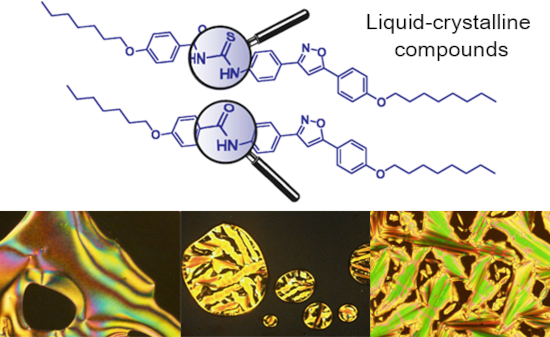Search results
Search for "anion sensors" in Full Text gives 8 result(s) in Beilstein Journal of Organic Chemistry.
Design, synthesis and application of carbazole macrocycles in anion sensors
Beilstein J. Org. Chem. 2020, 16, 1901–1914, doi:10.3762/bjoc.16.157

- sensor development, the results obtained in this work emphasize the importance of evaluating the binding behavior of receptors in real sensor membranes. Keywords: anion sensors; carboxylates; ionophores; macrocycles; sensor prototype; Introduction In 2013, Otto S. Wolfbeis asked the supramolecular
Synthesis of novel multifunctional carbazole-based molecules and their thermal, electrochemical and optical properties
Beilstein J. Org. Chem. 2020, 16, 1066–1074, doi:10.3762/bjoc.16.93
- combinations [14][15]. In sensor studies, carbazole derivatives are used as fluorophores. In this regard many different carbazole-based fluorophores are reported in the literature [16][17][18][19]. Some of the carbazole derivatives were used as colourimetric anion sensors [20], and others as biothiol sensors
The use of isoxazoline and isoxazole scaffolding in the design of novel thiourea and amide liquid-crystalline compounds
Beilstein J. Org. Chem. 2020, 16, 175–184, doi:10.3762/bjoc.16.20

- components, which may be substituted symmetrically or unsymmetrically [1]. Applications of this scaffold include complexing agents in anion sensors [2] organocatalysts [3], intermediates in heterocycle synthesis [1] and development of compounds with pharmacological effects [4]. Considering the importance of
1,2,3-Triazolium macrocycles in supramolecular chemistry
Beilstein J. Org. Chem. 2019, 15, 2142–2155, doi:10.3762/bjoc.15.211
- , we highlight the recent advances in the synthesis and applications of triazolium macrocycles as anion sensors, molecular reactors, and pH sensors through the description of selected examples. The macrocycles involved vary from having relatively simple structures to being part of different types of
Mechanochemical synthesis of thioureas, ureas and guanidines
Beilstein J. Org. Chem. 2017, 13, 1828–1849, doi:10.3762/bjoc.13.178

- years, molecules with incorporated (thio)urea and guanidine subunits, due to their ability to coordinate other molecules and ions via N–H hydrogen bonding, have also been considered as organocatalysts and anion sensors [7][8][9][10][11][12]. In Scheme 2, several examples of (thio)urea- and guanidine
- paper, the ball milling approach was then applied for a quantitative click-mechanosynthesis of thiourea-based organocatalysts and anion sensors (Scheme 5) [34]. The demonstrated efficiency of mechanochemical milling synthesis of thioureas was exploited for a quantitative transformation of
- bis-thioureas which were tested as cyanide anion sensors in DMSO solution. Our group continued the research on the solid-state synthesis of thioureas focusing now on the reactivity of sterically hindered ortho-phenylenediamine (o-pda) with isothiocyanates [35]. Whereas Kaupp's approach to prepare a
Fluoride-driven ‘turn on’ ESPT in the binding with a novel benzimidazole-based sensor
Beilstein J. Org. Chem. 2015, 11, 563–567, doi:10.3762/bjoc.11.61
- ]. However, to OH-based anion sensors it has been paid less attention [25][26]. In fact, we have succeeded in designing and synthesizing the anion fluorescent probes, based on ESPT [15][16], containing phenolic OH as H-bond donor. In these systems, the probe displayed a narrower linear range for fluoride
- . Furthermore, to the best of our knowledge, there were few reports on the anion sensors containing both NH and OH binding sites [14][25][27]. On the foundation of the above-mentioned background, herein we report the synthesis and H-bond donor ability of the novel anion sensor (E)-2-(((1H-benzo[d]imidazol-2-yl
Fluorescent hexaaryl- and hexa-heteroaryl[3]radialenes: Synthesis, structures, and properties
Beilstein J. Org. Chem. 2012, 8, 71–80, doi:10.3762/bjoc.8.7
- large Stokes shifts, suggests that these compounds would be useful as sensor components. Indeed, our efforts to investigate anion–π interactions [43] are being undertaken with a view to utilise [3]radialenes as a building block for the synthesis of anion sensors. Conclusion In summary, this work has
- nature of the [3]radialene core to act as anion receptors. The useful electrochemical and fluorescence properties of these compounds may allow them to be employed as building blocks of anion sensors. Experimental General experimental Melting points were determined using a Gallenkamp variable heat melting
Synthesis and characterization of new diiodocoumarin derivatives with promising antimicrobial activities
Beilstein J. Org. Chem. 2011, 7, 1688–1696, doi:10.3762/bjoc.7.199
- ]. Moreover, coumarin-based dyes and pigments are organic fluorescent materials exhibiting unique photochemical and photophysical properties, which render them useful in a variety of applications such as dye lasers, anion sensors, organic light-emitting diodes and solar cells [9][10]. Iodo-organic derivatives


































































































